Plant Homeopathy
The following will give growers a two part series which allows readers to get an understanding, a grip and a hands-on entry to a new method which they can apply to their own practice, whether garden, orchard or vineyard.
Part 2 Homeopathy for Plants – Case Practice
This first issue provides an introduction to Plant Homeopathy and a ‘get your head around’ background theory to awaken some interest, also this first part gives some practical details for the winter and pruning season.
The second issue will cover topics such as preparing the busy spring time soil, and plant needs and wants for good first growth of shoots and roots. Additionally it will be dealing with seed beds, transplanting and stress relief. Also it will go into details of disease prevention and how to treat acute and chronic soil and plant conditions and problems.
Introduction
As the author of this series, I Andreas Welte, own and manage a family farm/orchard called Castle Rock Ranch at Marahau near Motueka. About half of the 300 acres of land is farmed, the rest is pristine bush and regenerating bush.
The orchard grows apple, pear, apricot, olive, cherry and table grape, close to the house is a vegetable garden. Farmwise there are eight fenced paddocks running a herd of nursing cows of around 40 heads to produce beef for the market. All the land has been managed organically/bio-dynamically since 1990. All animals have been treated homoeopathically since then, all crops have been treated with plant homeopathy for fifteen years.
Back in Germany I studied agricultural sciences completing a degree in 1981. Before entering university I undertook an agricultural/horticultural apprenticeship on biodynamic, organic and conventional farms in Switzerland, Canada and Germany. During this time and thanks to my brother who is a medical doctor specialising in classical homeopathy, I developed the interest in homeopathy.
A tertiary degree in Germany is obtained by finishing all university exams and then dedicating half a year to write a thesis on a subject close to heart and mind. My preferred choice was to write on ‘Homeopathic treatment of crops’ because my practical experience and studies had convinced me of the potential and effects of minute quantities of material, biological inputs and their tremendous energies while experiencing the application of ‘dynamised preparations’ on the Suisse bio-dynamic farm orchard. My professor in plant science did not agree with this idea and said: “there is no such thing as homeopathy for plants, go and ask the veterinary department to write something on homeopathy for animals.
Some fifteen years later after coming to New Zealand I could set into practice, what I had intended to do. I permitted myself to treat all crops and animals with homeopathy. But could I just use the knowledge and experience I had gained on animals on plants as well? A five year long learning curve gave me parts of the answer: you’ll be learning for the rest of your life. During those five years several homeopathic remedies have been trialled on the pip fruit, stone fruit and grape to treat curly leaf, mildew (downy and powdery), brown rot and blackspot (Venturia inaequalis).
Various homeopathic remedies like equisetum, silicea, sulphur, cuprum met., potentised clay, cow dung and nosodes (potentised diseased parts of fruit and leaf) have been used, not exactly knowing which potency and how much of it had to applied to get best results.
Basic principles of Homeopathy
Law of Similars
Homeopathy is medical edifice of thoughts and ideas of Dr.Samuel Hahnemann (1755-1843). Its main guiding principle is the law of similars which is called “simila similibus curentur” or “like is cured by like” (1). For example plants grown in lime deficient soil show stunted growth and leaves of greyish colour. Treating a healthy plant with Silicea will produce exactly those symptoms. Applying potentised Silicea to a plant with the same symptoms will reinvigorate that plant and bring it back to good health. We are always treating the whole plant and the soil it grows in. Actually we are treating all the symptoms that can be observed, the cause for those symptoms, how these symptoms are manifested, where they are located, and what makes the symptoms better or worse. (2)
Proving
This principle relates to the method of testing substances on healthy plants and observing all the symptoms to determine the medicinal effects. Once we know the proving and combine it with the modalities which describe the conditions in which a symptom gets better or worse, we can chose the most adequate remedy.
Principle of Potentisation
This is about the correct preparation of the selected remedy. According to S. Hahnemann this dynamisation involves dilution and rhythmic succussion (hitting the jar with the diluted mix against a book case of a thick book or on a wooden block) of the original substance after dissolving it in alcohol or triturating it with lactose to form little round balls called globuli. This dynamic process transforms the matter of the remedy’s original substance into an energetic pattern bearing the infor-mation from the remedy in a non-material form. This energetic form matches the vital energy of the plant like the correct key fits the lock. The more it is diluted and dynamised, the stronger is its effect. The D potencies (D1-D23) are so-called low potencies which still contain some of the original substance’s matter and are best used as fertiliser. D means decimal dilution by 1:10 = D1, take one part of D1 and dilute it again by 1:10 leads to D2 and so forth.
The C potencies (C for centesimal) C30 and C200 are high potencies which no longer contain molecules of the original substance after their dynamisation (dilution, succussion). They are very powerful and unexperienced ley persons may cause more harm than cure if administering them in the wrong way. (3) Here one part of the mother tincture is diluted with one hundred parts of the neutral carrier to get the C1 potency, one part taken out of that diluted with another one hundred parts of the carrier leads to C2 and so forth.
Materia Medica
Each remedy has a distinct description of its various qualities and characteristics to help the grower to find the correct one to treat the observed symptoms of a dis-ease with. A list and categorisation of most likely remedies is called Materia Medica. A Materia Medica is to include all substances which have been proved and which have been used with apparent efficacy. (4)
Repertory
In homeopathy a certain tool was developed to link all the observed symptoms of a disorder with the potential choice of remedies listed in the Materia Medica. As many remedies were studied, there needed to be a way to organize the information. The flow of information was like this: provings to materia medica to repertory. (5)
In Christine Maute’s book, a plant repertory is included in form of a Table of Modalities which crosslinks a certain set of symptoms or disorders with the best possible homeopathic remedies to be applied.
One remedy only
Provings of homeopathic remedies are done by proving one substance at a time. If later used in a combination it is not clearly known how they might interact, counter act or neutralise each other. Classical homeopathy therefor uses only one remedy at a time.
Dosage and administration of C potencies
Home garden: Crush 6-8 globules in 150 ml water using a wooden spoon (not metal). Make sure all globules are diluted properly before application. Succuss the jar against a book case for about ten times to reinvigorate the energies held in the globules before mixing the 150 ml with 30 litres of water to obtain your spray volume. This is the volume for three back pack spray tanks.
Orchard/Vineyad size: Crush 60-80 globules in 1.5 litres of water. Succuss as above and add to your 300 litres spray tank. Make sure that your tank has been well cleaned before using it for homeopathic remedies. Use clean water only, not of any chlorinated source.
Apply as mist and cover the plants to run-off coverage, also apply to the ground as the soil gets treated at the same time as the plant it grows.
Dosage and administration of D potencies
D potencies are better used to build up and strengthen plants, as much as to fertilise the surrounding soil and to deter and fight unwanted insects. Use about ½ a teaspoon of D6 globules crushed and stirred in 10 litres of water in the home garden. Use ten times the amount for 100 litres in your orchard or vineyard spray tank. Again, make sure to cover the soil around the roots as much as the plant.
Basic rules:
- Do not repeat the dose while the plants are getting better
- Only repeat the dose if the plants show slight signs of improvement and then the disorder returning in the same way as before (6)
- With homeopathic plant treatment right now we are right at the beginning. Therefor it is a good idea to share our experience as much as possible
- At info@ecogrape.com we are starting a shared web link where all interested growers can join this new path and build a network for common growth
What are good reasons to apply Homeopathy for Plants?
- Homeopathy works for humans, animals and plants
- Homeopathy supports the self-healing inner forces
- Homeopathic remedies are residue free, safe and work very gently
- No addiction, side effects or suppressed symptoms
- Homeopathy has the smallest ecological footprint and does not waste limited resources
- Homeopathy is very economical
- Homeopathy goes hand in hand with organic and biodynamic methods
Practical hints for the winter/pruning season
Apply Arnica C30 as recommended after all pruning cuts have been done. Apply it to cut wounds and soil in the root zone.
Arnica montana (ex Materia Medica)
– General effect
Consequences of blows, impact, being dropped;
Excellent tonic for all plants
Improves circulation in the plant’s capillary system
Arnica ensures that the plant is properly supplied right through to the shoots and tips
– Damage caused by errors in cultivation
Injuries from pruning
Injuries from transplanting or relocation
– Weather damage
After plant injuries from hail, storm and wind (e.g. breakage); (7)
We wish all growers a good winter season and best success with any new beginnings using the exciting method of Homeopathy for their plants.
Andreas Welte, May 2015
References
(1) The Spirit of Homeopathy, Rajan Sankaran, Homeopathic Medical Publishers, Mumbai, India
(2) Homeopathy for Plants, Christiane Maute, Narayana Publishers, page 5, Kandern, Germany
(3) Homeopathy for Plants, Christiane Maute, Narayana Publishers, page 7, Kandern, Germany
(4) Homeopathic Materia Medica, Oscar E. Boericke, Narayana Publishers, page ix, Kandern, Germany
(5) New World Veterinary Repertory, Richard Pitcairn&Wendy Jensen, Narayana Publ., page vii, Kandern, Germany
(6) Homeopathy for Plants , C. Maute, page 12
(7) Homeopathy for Plants, C. Maute, page 112
Go to part two – Homeopathy for Plants Part 2
Homeopathic Plant Management
Common pest of grapes
Pseudococcus maritimus (Homoptera: Pseudococcidae)
It is slow to spread from vineyard to vineyard, but once a vineyard is infested, the infestation is difficult to clean up.
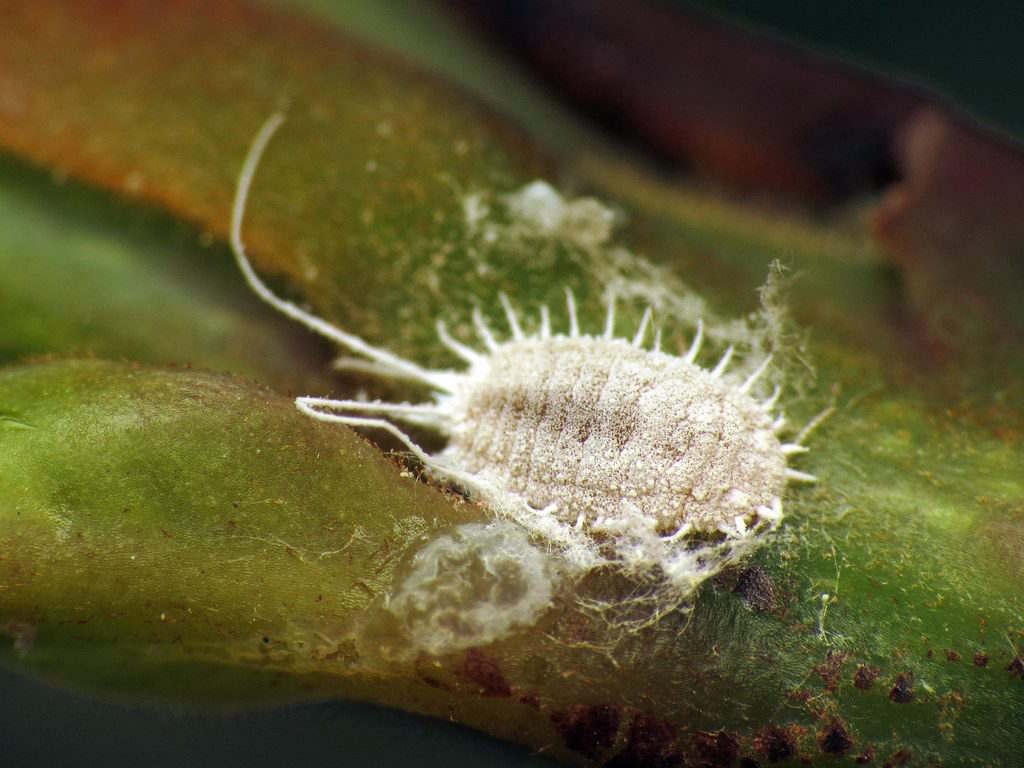
Grape mealybug nymph
Hosts
Grapevine mealy bug attacks many plant species including all tree fruits as well as other rosaceous plants, grapevines, ornamental trees and shrubs. This insect is able to develop new host strains, which allows it to adapt to more hosts. Adaptations may include different development rates and numbers of generations per year.
Life stages
Egg
The egg is a salmon coloured, elongated oval. Eggs are laid in masses of waxy filaments that have a cottony appearance.
Nymph
The 1st instar nymph, or crawler, is pink to salmon coloured and has well developed legs. The crawler is covered with a light coating of waxy granules, giving it the appearance of being coated with flour. After settling to feed, the crawler moults into a sedentary nymph, and the coating of wax becomes heavier.
Adult
The adult female is wingless and looks similar to a nymph. It can be up to 5 mm long. It has a well developed ring of waxy filaments around the sides of its body.
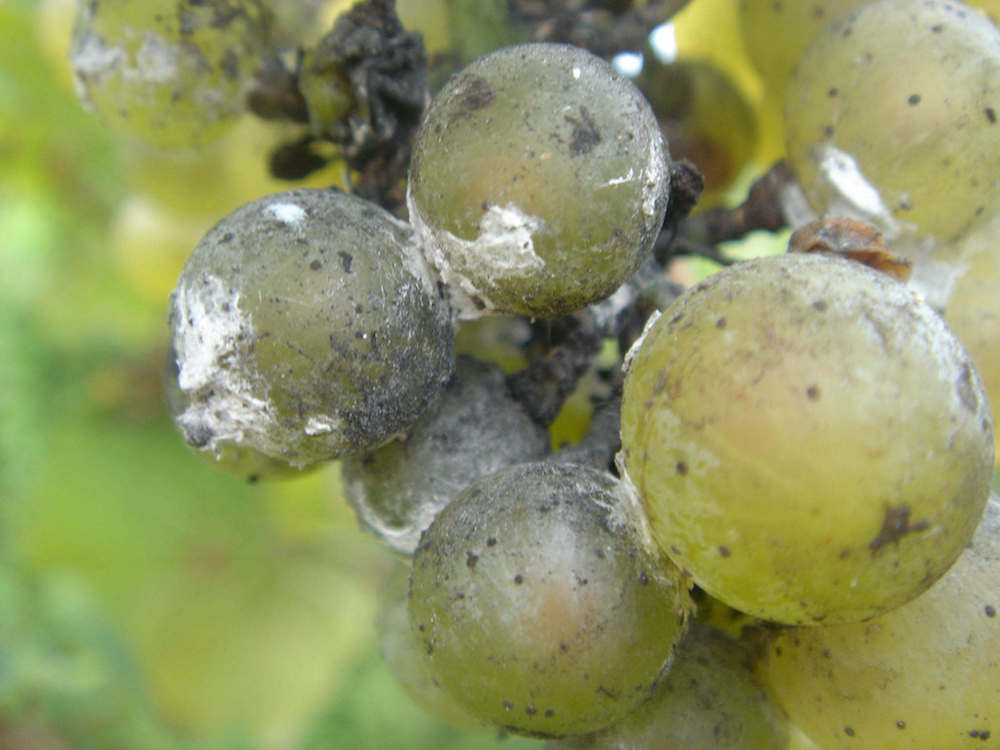
Grape mealybug
Filaments are longest at the posterior end of the body and become progressively shorter towards the front of the body.
The adult male is much smaller than the female and has wings held flat over the back. It is a fragile insect and resembles a male scale.
Grape mealy bug overwinter as eggs or crawlers within the loose cottony egg sac under bark scales on scaffold limbs, in other sheltered places on trees, or in litter at the bases of grapevines.
Crawlers start emerging at the beginning of bud swell and begin feeding on the bases of buds. When buds open they go directly to new shoots and leaves. Crawler movement occurs over a long time, ending at about petal fall. 1stgeneration nymphs mature during late Dec/Jan. Mated females migrate to sheltered areas, lay eggs and die in the egg sac. A partial 2nd generation matures in late Feb/March.
Damage
The most obvious damage by grapevine mealy bug results from the honeydew it secretes. Honeydew is cast off in small drops and falls down through the canopy. When it lands on fruit it causes a coarse, black russet. Sooty mould grows in the honeydew. This fungus taints the flavour of the resulting grape juice.
Monitoring
Check during the dormant season for eggs and crawlers in egg sacs under bark scales. The white cottony mass makes egg sacs easy to see. During delayed-dormant and cluster bud stages, crawlers can be monitored by examining developing buds on spurs. It is easy to detect infestations in late Dec/Jan when mature females are crawling back to larger spurs to deposit eggs or during harvest when damaged grapes are evident in bins.
Biological control
Many generalist predators, such as lacewings, ladybird beetles and predaceous bugs, will feed on mealy bug. Often the predator numbers don’t control mealy bug well enough. (1)
After initializing and establishing ‘Homeopathic Plant & Soil’ initiative in January 2020 in Nelson and Upper Moutere, a trial series was set up in Upper Moutere, Gisborne and Western Australia/Windance Wines in vineyards of HP&S members. A program had been established by EcoGrape/Sustain-Ability Ltd during the last three years and was ready to be put in motion. Based on actual symptoms of mealy bug and their damage caused, a strategy could be developed.
With the help of clinical, epidemiological and laboratory data, reasonable conclusions could be gathered about the group of homeopathic medicines that would work in this vine infection. An in-depth analysis of the recorded symptom-set of affected grapevines was done with the use of the principles of the Homeopathic Organon according to Dr Samuel Hahnemann and the tools of Repertory and Materia Medica (2) to find the adequate remedies in a scientific manner.
Comparing Keynotes of various optional medicines and comparing them with the help of the so called ‘Polarity Analysis Method’ of Dr Heiner Frei, CH (3), the remedy was composed of a potentised plant ingredient that keeps away ants which are usually milked by the mealy bug which eat their sugary secretion, and another one which directly keeps away the mealy bug. Two organic vineyards in Gisborne and WA applied two selected 30C potencies this late summer and were really pleased with the result:
”usually my vines would be black right now, after applying the homeopathic remedy together with the biodynamic Silica 501 preparation, there was a significant decrease in mealy bug numbers in the grapevines in early March” the Gisborne grower says. The remedy is 30C potency and as such trans-molecular, fine matter energy only based. It is BioGro NZ certified, harmless to beneficial insects, growers, soil, water and plants. It has a zero carbon footprint and has been researched and tested by EcoGrape/Sustain-Ability Ltd, Nelson.
(1) wsu.edu
(2) – Homeopathy for Plants, Christiane Maute, available through EcoGrape.com
Homeopathic Materia Medica and Repertory, O.E. Boericke
(3)– Polarity-Analysis, Heiner Frei, polarity-analysis.com
Andreas Welte, March 2020

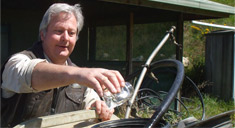
Contact Us
General enquiries welcomed. Request consultancy advice or speak to Andreas directly.
Contact Andreas
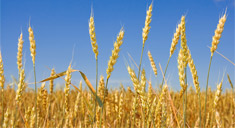
Order Online Now
Order our Farm and Plant Homeopathic and Organic & Biodynamic Viticulture & Horticulture products.
Order Online
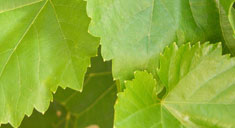
Plant Homeopathy
Based on classical homeopathic principles, we offer advice on homeopathic treatment
Read On ...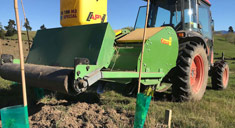

Soil Cultivation
ESTA Soil Tests and analysis and Soil Management using the Spade Machine.
Find out more